In this comprehensive article titled “Historic Forts in Michigan,” we journey through time, tracing the origins, tales, and significance of Michigan’s historic bastions. These forts, often strategically positioned at critical junctures, were not just military defenses but also vibrant economic, social, and political hubs.
From the early confrontations between European settlers and indigenous tribes to the tumultuous times of the Civil War, these strongholds have played a pivotal role in shaping the state’s history. As we delve into their stories, we aim to offer readers a richer understanding of the architectural marvels, the courage of their defenders, and the broader narrative they contribute to.
By the end, we hope you gain knowledge about these fortresses and feel renewed pride and awe for the landmarks that once stood as the protective sentinels of Michigan’s doorfront.
Historic Forts in Michigan
| 1. Fort Mackinac | 6. Fort Shelby |
| 2. Fort Michilimackinac | 7. Fort Wayne |
| 3. Fort Drummond | 8. Fort Wilkins |
| 4. Fort St. Joseph | 9. New Fort Brady |
| 5. Fort Detroit | 10. Fort Miami |
1. Fort Mackinac
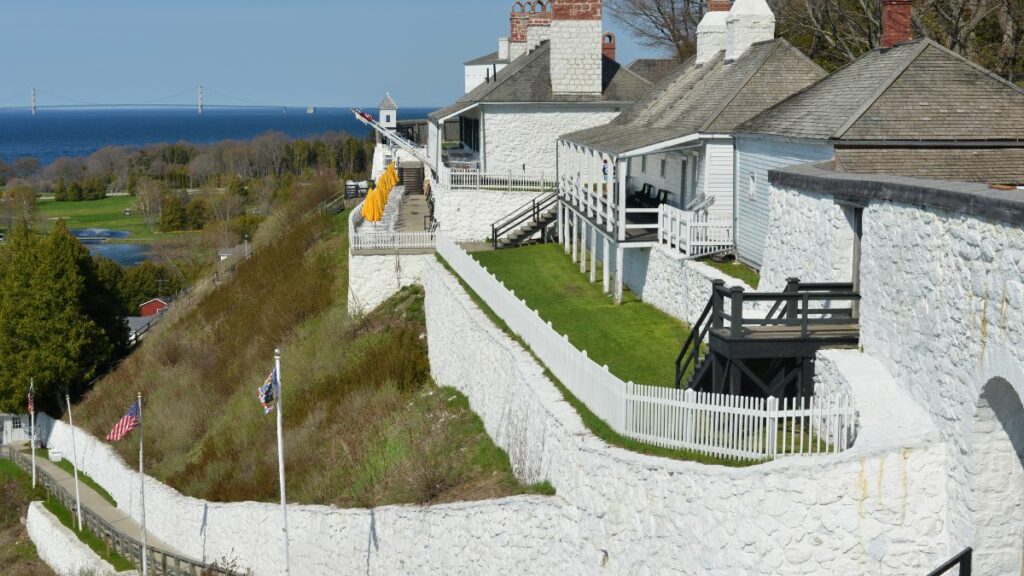
Located on the picturesque Mackinac Island in Michigan, Fort Mackinac proudly stands atop a 150-foot limestone bluff. This strategic location renders it a symbol of historical significance and offers visitors breathtaking views of the Straits of Mackinac and the iconic Mackinac Bridge.
The fort’s relationship with its surroundings is harmonious, blending the architectural marvel of the past with the awe-inspiring natural beauty of the present.
Historical Background
Fort Mackinac’s roots trace back to the tumultuous times of the American Revolution. In 1780, amidst the backdrop of war, British soldiers recognized the strategic significance of the Straits of Mackinac, which bridged the waters of Lake Michigan and Lake Huron. To exercise control over this crucial junction, they established Fort Mackinac.
However, the fort’s early years were marked by conflict. During the War of 1812, it was at the center of military confrontations. In an early stage of the war, British forces successfully captured Fort Mackinac from the Americans. Yet, as the tides of war shifted and the Treaty of Ghent was penned, the fort was restored to American control.
While the 19th century saw a decline in the fort’s military prominence, it remained an active post. It evolved into a community nexus, hosting gatherings and events and remaining garrisoned with American soldiers.
But by 1895, the clarion calls of battle had long faded, and Fort Mackinac began its transformation, emerging as one of the pioneering national parks in the United States.
Contemporary Significance
In the present day, Mackinac National Park welcomes thousands of tourists annually it offers an immersive journey back in time. The fort’s well-preserved original buildings, complemented by engaging historical reenactments, provide a vivid picture of life during its operational years.
Beyond mere historical appeal, Fort Mackinac also serves an educational purpose. It fosters a comprehensive understanding of its role in shaping American geopolitics and society. As visitors walk its ramparts, explore its rooms, and listen to the tales of its past, they are reminded of the nation’s challenges, triumphs, and enduring spirit.
In a rapidly evolving world, places like Fort Mackinac play an invaluable role. They bridge the gap between yesteryears and today, allowing generations to appreciate, learn from, and connect with their heritage.
2. Fort Michilimackinac
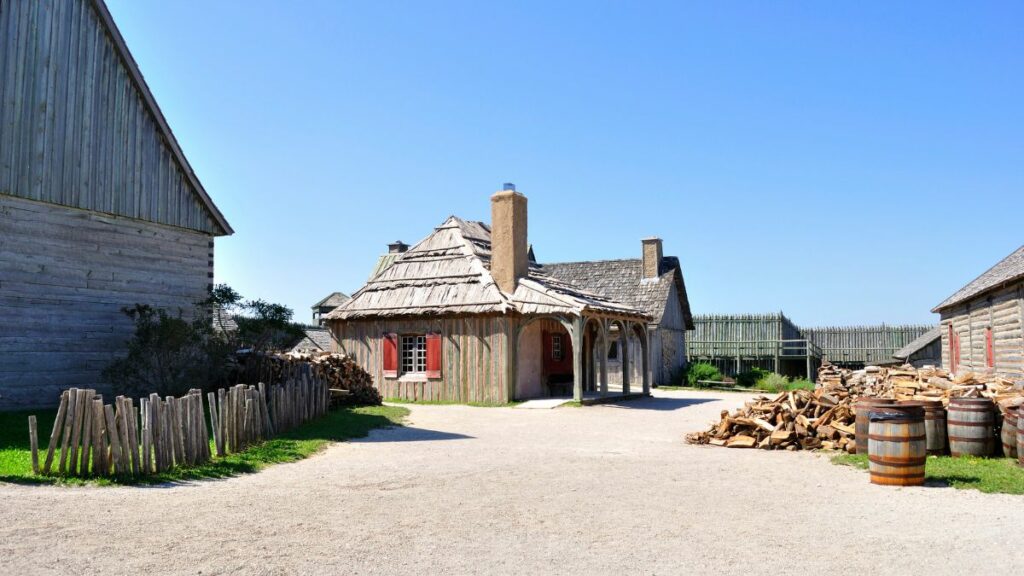
Located at the crucial junction of Lake Michigan and Lake Huron, Fort Michilimackinac highlights a dynamic period of history characterized by trade, alliances, and cultural dialogues. Its importance is not merely as a military stronghold, but also as a representation of the complex network of relationships in the fur trade era.
As it was often referred to, Colonial Michilimackinac is a testament to the intricate weave of histories that unfolded there.
Fort Michilimackinac’s geographic positioning was paramount, particularly during the flourishing fur trade era. This period saw a surge in economic activities, with furs being highly sought after in European markets. The fort’s location made it a prime spot for trade, acting as a conduit for goods and commodities.
But Colonial Michilimackinac wasn’t solely about trade; it was a melting pot of cultures and communities. It was an essential bridge, fostering interactions between Native Americans and European settlers.
This unique confluence turned the fort into more than just a military outpost; it evolved into a bustling trading hub, teeming with activity and animated by the myriad voices of traders, soldiers, indigenous peoples, and settlers.
Roles and Functions
While its defensive structures and stationed troops underscored its military significance, the heart of Fort Michilimackinac pulsed with commerce.
Native American tribes brought in furs and other goods, exchanging them for European wares, tools, and textiles. This trade transformed the fort into a bustling marketplace with intertwined interests, stories, and cultures.
The interactions at Fort Michilimackinac also facilitated a deeper understanding and sometimes challenging dynamics between Native Americans and European settlers.
This interplay was not just in terms of trade but extended to cultural exchanges, negotiations, and at times, confrontations.
Fort Michilimackinac Today
Today, Fort Michilimackinac serves as a window into a bygone era. It offers a rich tapestry of stories that shed light on the intricate relations during the fur trade epoch.
Visitors to the fort are transported back in time, walking through the reconstructed structures, observing reenactments, and imbibing the spirit of the times when the defense was a bustling hub.
3. Fort Drummond

Positioned strategically on Drummond Island in Michigan, Fort Drummond possesses a layered history that intermingles with the broader tapestry of the Great Lakes region.
Though not as renowned as some of its contemporaries, the fort’s story is one of strategic maneuvering, shifting alliances, and the broader geopolitical landscape of its time.
Historical Backdrop
In the early 19th century, with the War of 1812 underway, the British understood the strategic necessity of having a presence in the Great Lakes region.
As a result, Fort Drummond was established in 1815 by the British as a replacement for Fort Mackinac, which they expected to cede to the United States after the war. Their anticipation proved correct when the Treaty of Ghent, which ended the war, mandated British withdrawal from the territories.
Fort Drummond, however, wasn’t immediately relinquished. The British maintained their presence on Drummond Island until 1828, primarily due to delays in finalizing border agreements. This extended occupation allowed a unique community to thrive around the fort, including military personnel, traders, and Native American allies.
While its military relevance was undeniable, Fort Drummond also played a vital role in fostering ties with Native American tribes in the region.
The fort acted as a gathering point, a nexus for discussions, and a venue for forging alliances. The symbiotic relationship was built on mutual respect, shared interests, and, occasionally, shared adversaries.
The fort’s existence highlighted the uncertainties and fluidities of international borders during this period. Even after the Treaty of Ghent, it took years for the British to finally relinquish their hold on Drummond Island, underscoring the intricacies of geopolitics in the post-war era.
Modern-Day Legacy
While Fort Drummond’s physical remnants may have waned with time, its legacy continues. The fort’s history serves as a reminder of the complex interplay of forces—be they military, political, or cultural—that have shaped the Great Lakes region.
Visitors to Drummond Island can still find traces of Fort Drummond’s past. Through these echoes, they can connect with a chapter of history that offers lessons in diplomacy, alliance-building, and the ever-evolving nature of borders and territories.
4. Fort St. Joseph
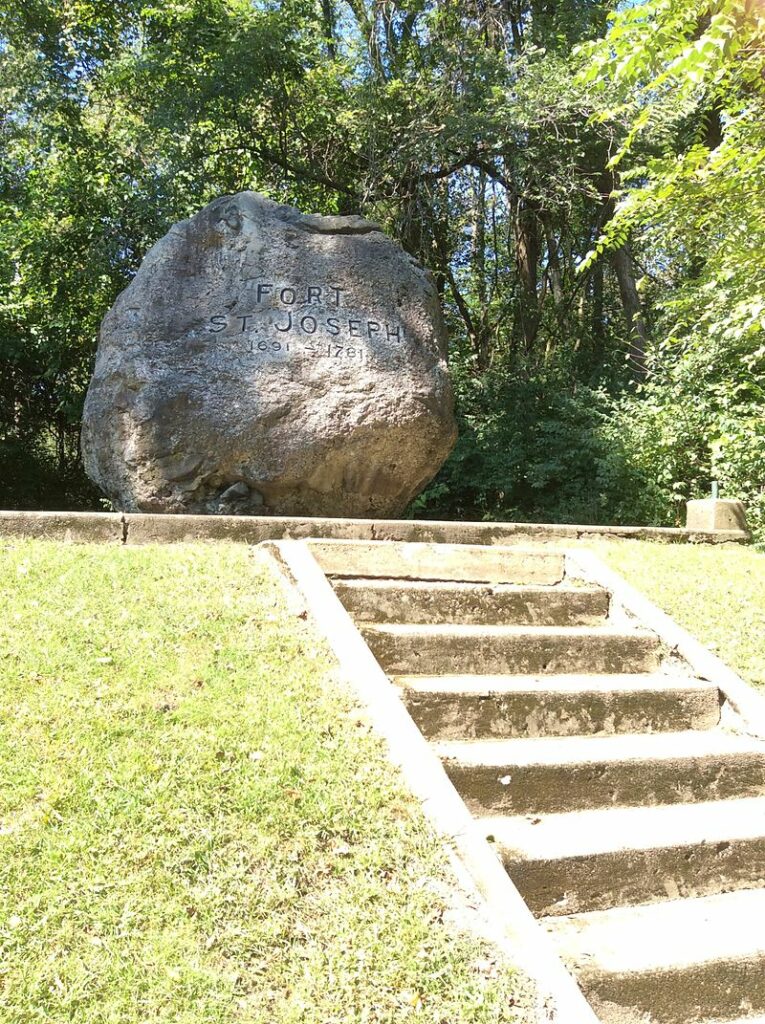
Situated on the banks of the St. Joseph River in what is now Niles, Michigan, Fort St. Joseph stands as a symbol of the multifaceted history of the Great Lakes territory.
Established amidst colonial rivalries and the quest for dominance, the fort represents the fluid dynamics of European powers and their relationships with Native American communities during its era of operation.
Fort St. Joseph was established in the late 17th century by the French as a fur trading post and missionary hub. The choice of location was deliberate, leveraging the St. Joseph River as a conduit for trade, transportation, and communication.
This fortification was integral to the French strategy of establishing a network of posts to control the lucrative fur trade and spread Catholicism among Native American populations.
Europes Influence
As European territorial disputes in North America intensified, Fort St. Joseph saw its allegiances shift. In 1761, it was transferred from French to British control due to the Treaty of Paris, which ended the French and Indian War.
The fort, however, faced challenges under British rule, most notably during Pontiac’s Rebellion in 1763 when Native Americans, discontent with British policies, captured the fort. It eventually returned to British hands but was later taken by the Spanish in a surprise raid in 1781.
Fort St. Joseph was more than just a military stronghold throughout its existence. It was a vibrant commercial hub, pivotal in the fur trade. French coureurs de bois and voyageurs exchanged goods with Native American tribes, and the fort became a bustling center of commerce, diplomacy, and cultural exchange.
Its missionary origins also meant that Fort St. Joseph was a center of religious endeavors. French Jesuit missionaries sought to convert Native American communities, leading to a complex tapestry of faith, culture, and politics.
Fort St. Joseph Today
Though the physical remnants of Fort St. Joseph are limited, archaeological efforts have unearthed artifacts and structures, helping piece together the fort’s storied past. Today, the site serves as a bridge to a bygone era, allowing visitors to explore the intricacies of colonial North America.
Annual reenactments, educational programs, and archaeological digs at the Fort St. Joseph site provide insights into the daily lives of its inhabitants and the broader geopolitical tensions of its time.
5. Fort Detroit

Strategically positioned along the Detroit River, Fort Detroit, known initially as Fort Pontchartrain du Détroit, was founded by the French in 1701.
Established by Antoine Laumet de La Mothe, sieur de Cadillac, the fort served as a key French outpost in the region, facilitating trade and acting as a bulwark against British expansion in the Great Lakes.
British Control and the Shadow of Rebellion
By 1760, the tides of war and diplomacy brought Fort Detroit under British control, a transition solidified by the Treaty of Paris in 1763. However, the fort’s new custodians soon faced challenges.
Notably, during Pontiac’s Rebellion in 1763, a confederation of Native American tribes, led by the Ottawa leader Pontiac, besieged the fort. While the siege ultimately failed, it highlighted the tensions between the British and the region’s indigenous peoples.
American Acquisition and the March of Time
Following the American Revolution, Fort Detroit transitioned to American hands based on the terms of the Treaty of Paris of 1783.
As the 19th century progressed and the city of Detroit expanded, the fort’s significance as a military installation dwindled. Eventually, the structures of Fort Detroit were dismantled, making way for a burgeoning cityscape.
Preserving the Legacy: Reflections in Modern Detroit
While Fort Detroit’s physical structures might have faded into history, its legacy is indelibly etched into the fabric of modern Detroit. The fort’s location and the subsequent city’s growth have been influenced by the crossroads of cultures, trade, and military strategies that once defined the fort’s existence.
Today, through historical markers, museums, and cultural programs, the stories of Fort Detroit continue to be celebrated and remembered.
From its early days under French flags to its pivotal role in the geopolitical struggles of North America, Fort Detroit stands as a testament to the ever-shifting dynamics of power, trade, and community in the heart of the Great Lakes.
6. Fort Shelby
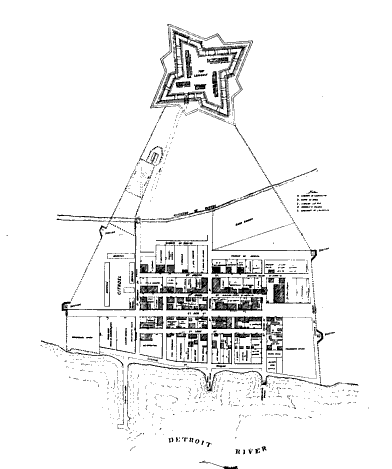
Fort Shelby, initially named Fort Lernoult and later renamed in honor of Kentucky’s first governor, Isaac Shelby, was erected in Detroit in 1778.
Established by the British during the American Revolutionary War, the fort was a strategic response to American advancements in the region, specifically to protect British interests after they retreated from Fort Detroit.
Transitioning Hands: From British to American Control
After the American victory in the Revolutionary War, the terms of the Treaty of Paris in 1783 should have seen Fort Lernoult transferred to American control.
However, the British lingered, only officially ceding it to the United States in 1796. Under American command, the fort was renamed Fort Detroit, and later, in the early 19th century, it became Fort Shelby, commemorating the efforts of Isaac Shelby in the War of 1812.
War and Abandonment
The War of 1812 reignited conflicts in the region. Detroit and Fort Shelby surrendered without a fight to the British in 1812.
However, by 1813, American forces, led by future president William Henry Harrison, recaptured Detroit and the fort. Post-war, Fort Shelby’s prominence waned. By the mid-1800s, military activity at the fort dwindled, leading to its eventual abandonment and the structures falling into disrepair.
Echoes in Modern Detroit
Though Fort Shelby was eventually dismantled, its legacy persisted. In the 20th century, the Fort Shelby Hotel was constructed where the fort once stood, symbolizing a blend of history and modernity in Detroit’s urban landscape.
Today, Fort Shelby’s spirit is preserved through plaques, historical narratives, and Detroit’s collective memory. Its existence, marked by shifting allegiances and the ebb and flow of military strategies, is a compelling chapter in Detroit’s rich historical narrative, emphasizing the city’s pivotal role in North American geopolitics.
7. Fort Wayne
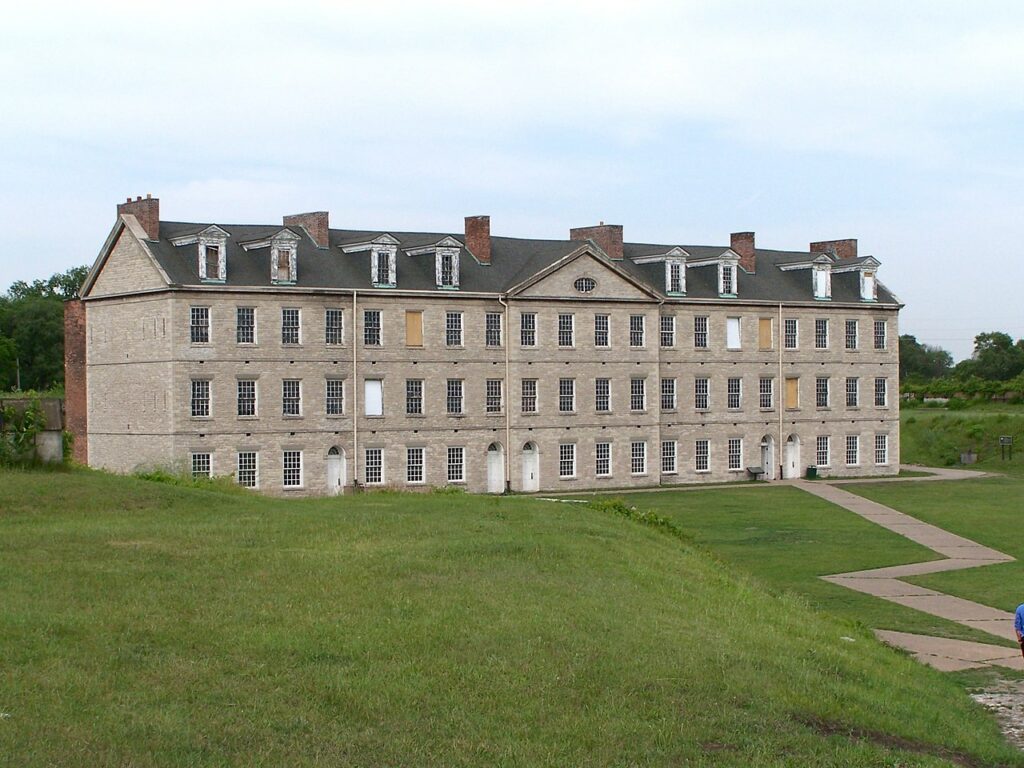
Located on the banks of the Detroit River, Historic Fort Wayne is the third military installation in the area, a continuity of Detroit’s strategic importance over the centuries.
Initially constructed in the mid-19th century, this compound provides an evocative journey through various periods, from the Spanish-American War to the dramatic times of World War II.
Diverse Historical Experiences
Apart from its fortified structures, Historic Fort Wayne offers many period settings. Once a hub of military drills and ceremonies, the parade ground now bustles with activity and events.
Visitors can return in time, experiencing the vibrant flea markets that blend historical artifacts and modern treasures. One of the most engaging sights is the vintage baseball games, with teams competing in traditional uniforms and playing by historical rules, reviving the spirit of America’s pastime from bygone eras.
Cultural Celebrations and Nearby Attractions
A stone’s throw away; the Tuskegee Airmen Museum stands as a poignant testament to bravery and determination.
Celebrating the legacy of the first African-American military aviators in the United States Armed Forces, the museum offers deep insights into their contributions during World War II, facing not only enemy combatants but also the challenges of racial prejudice.
A Confluence of Past and Present
Today, Historic Fort Wayne is a relic of the past and a vibrant attraction, drawing history enthusiasts and families looking for a unique recreational experience.
Its historical towers, engaging activities, and events give visitors a richer understanding of Detroit’s military and cultural legacy.
Historic Fort Wayne serves as a bridge between epochs, reminding visitors of Detroit’s pivotal role in shaping regional and national narratives while offering a delightful blend of education and entertainment.
8. Fort Wilkins
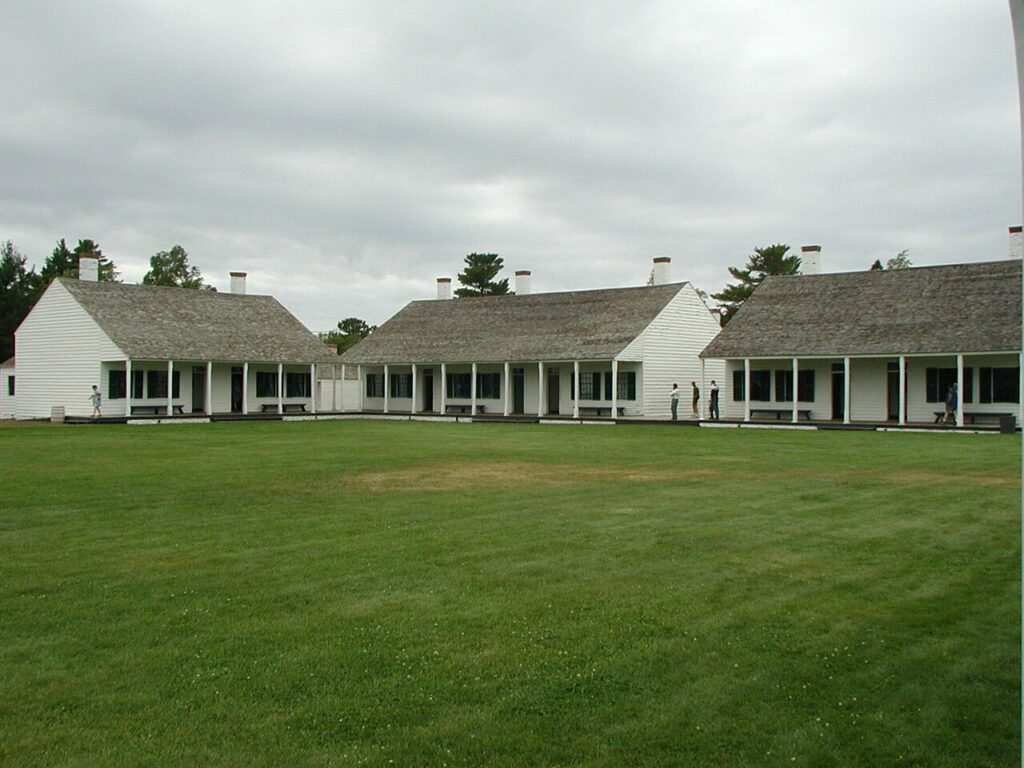
Fort Wilkins is situated in the northern reaches of Michigan’s Upper Peninsula, near Copper Harbor, as a sentinel to the area’s rugged past. Erected in 1844, the fort was designed to maintain order during the region’s copper boom.
As settlers and miners flocked to tap into the area’s rich mineral resources, Fort Wilkins provided security and stability in a remote frontier.
Military Operations and Short-lived Prominence
Though built for potential confrontations, Fort Wilkins essentially witnessed a peaceful tenure. The U.S. Army garrisoned the fort in its early years, maintaining a presence to oversee the growing influx of settlers and to address any tensions that might arise.
However, by the mid-1850s, as the region began to stabilize, the Army deemed the fort’s active military role redundant, leading to its abandonment.
Rebirth as a Historical Landmark
The passing of the decades saw Fort Wilkins fall into a state of disrepair. However, recognizing its historical significance, efforts were undertaken in the 20th century to restore and preserve the fort.
Today, it operates as a state park, with many of its original structures, including the barracks, officer’s quarters, and guardhouse, painstakingly restored to their 1840s appearance.
A Glimpse into Pioneer Life
Modern visitors to Fort Wilkins are transported back in time and allowed to explore life on the 19th-century frontier. Live reenactments, interpretive programs, and meticulously preserved structures offer insights into the challenges and aspirations of those who sought a new life amidst Michigan’s vast copper deposits.
Legacy and Modern Significance
Fort Wilkins stands today not as a testament to military might, but rather to the spirit of exploration and determination that characterized the American frontier.
It reminds us of the intricate balance between opportunity and adversity and the lengths to which society went to ensure the promise of a better future in uncharted territories.
9. New Fort Brady
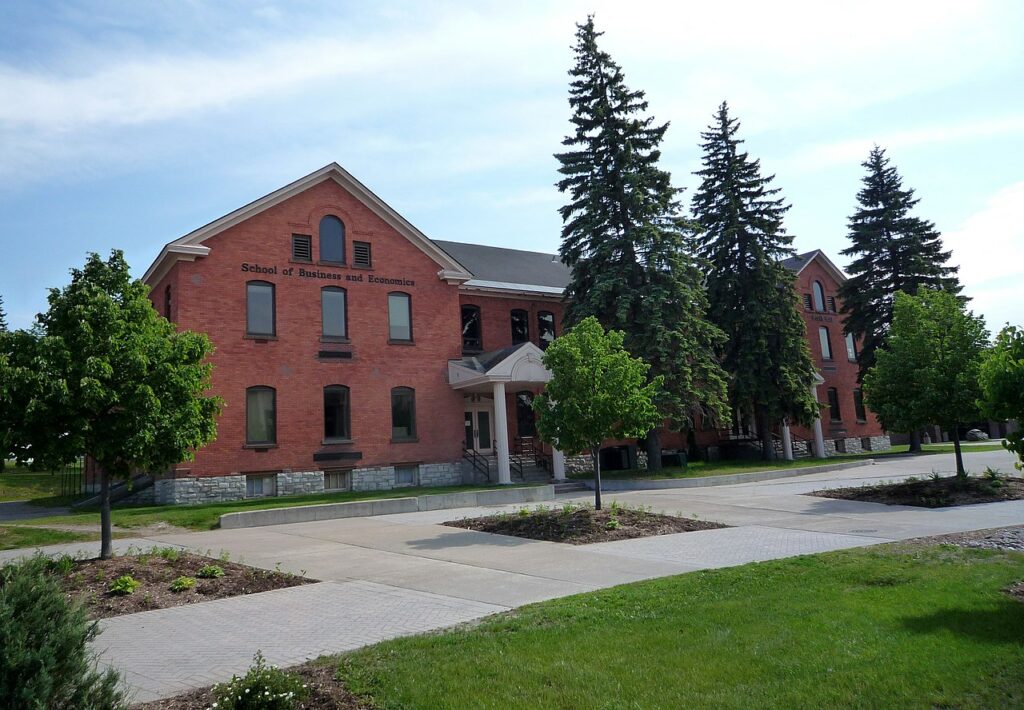
Situated in Sault Ste. Marie, Michigan, New Fort Brady was the successor to the original Fort Brady, established in 1822.
As the needs of the U.S. military evolved and the limitations of the actual location became apparent, the decision to relocate to higher ground was made in the late 19th century. Thus, in 1893, New Fort Brady emerged, signifying a new chapter in the fort’s history.
Strategic Role in Wars and Defense
Strategically positioned near the vital shipping channel of the Soo Locks, New Fort Brady played a pivotal role in safeguarding American interests. Its importance was particularly underscored during World War I and World War II.
The fort ensured that the critical transportation route remained unhindered, facilitating the movement of troops, resources, and supplies crucial to the war efforts.
Post-War Evolution and Educational Transformation
New Fort Brady’s active military role began to wane following World War II, as did many military installations. However, the fort underwent a remarkable transformation rather than fading into obscurity.
1946, the property was handed over to the Michigan College of Mining and Technology. This transition paved the way for establishing what is now known as Lake Superior State University.
A Blend of History and Modern Academia
Today, while the military drills and bugle calls have long ceased, the fort’s legacy lives on in the academic halls and lecture theaters of Lake Superior State University.
Many of the fort’s historic structures have been repurposed, serving as administrative buildings, classrooms, and landmarks on the university’s campus.
Legacy and Continuing Significance
New Fort Brady stands as a testament to adaptability and the enduring spirit of service. From its origins as a guardian of a crucial transportation route to its current role in shaping the minds of future generations, the fort symbolizes both heritage and progress.
Visitors and students can walk its grounds, reflecting on the fort’s rich military service and academic excellence tapestry.
10. Fort Miami

Sprouting up along the fertile grounds of the Maumee River in modern-day Ohio, Fort Miami manifested European power struggles in North America.
Initially erected by the French in the late 17th century, the fort was later rebuilt by the British in the 18th century, signifying its pivotal role in the colonial chessboard.
After the French relinquished their territories in the Treaty of Paris in 1763, the British sought to solidify their presence there.
As they reconstructed Fort Miami, the fort served as a military bastion and became a focal point for British alliances with Native American tribes. It played a crucial role during the Northwest Indian War and was a strategic post during Pontiac’s Rebellion.
American Revolutionary War and Aftermath
The shadows of the Revolutionary War weren’t lost on Fort Miami. Acting as a British stronghold was a testament to British resistance against American expansion.
Following the Jay Treaty in 1796, the British eventually vacated the fort, transferring control to the burgeoning United States.
Legacy and Modern Remembrance
While the physical structures of Fort Miami have largely succumbed to the sands of time, its historical imprint remains significant. The fort is a testament to the intricate interplay of European powers, Native American tribes, and the nascent United States in shaping the Midwest’s destiny.
In modern times, efforts to commemorate and remember Fort Miami’s legacy are evident. Historical markers, plaques, and educational programs offer insights into its multifaceted history, ensuring that its tales of diplomacy, warfare, and alliances continue to resonate with present and future generations.
Related: 10 Historic Forts in Nebraska
Conclusion – Historic Forts in Michigan
Michigan’s historic forts and historical structures have played an essential role in American history, particularly within Michigan. These military forts, located in areas such as Mackinaw City and Sault Ste. Marie served as a strategic location for protection and control, home to many significant events and stories of yesteryear.
The oldest building among these historic sites stands as a testament to the longevity and resilience of these establishments. Many of these structures are listed on the National Register of Historic Places, drawing history buffs from all over to appreciate and learn from their storied walls.
These forts are more than just remnants of the past. They bridge the nation’s history and its present, serving as living reminders in places like Mackinaw City and Sault Ste. Marie.
Both locals and visitors flock to these historic sites, ensuring that the memories of those who served at these military posts remain vivid. Through their perseverance, these sites continue to unite and educate, underscoring the importance of unity in adversity.
Thanks for reading, and if you have visited any of these forts, we would love to hear about your experience and what you learned in the comments section below.

Cory is a website owner and content creator who enjoys fishing, history, coin collecting, and sports, among other hobbies. He is a husband and father of four.
Romans 15:4 For whatever was written in former days was written for our instruction, that through endurance and through the encouragement of the Scriptures we might have hope.

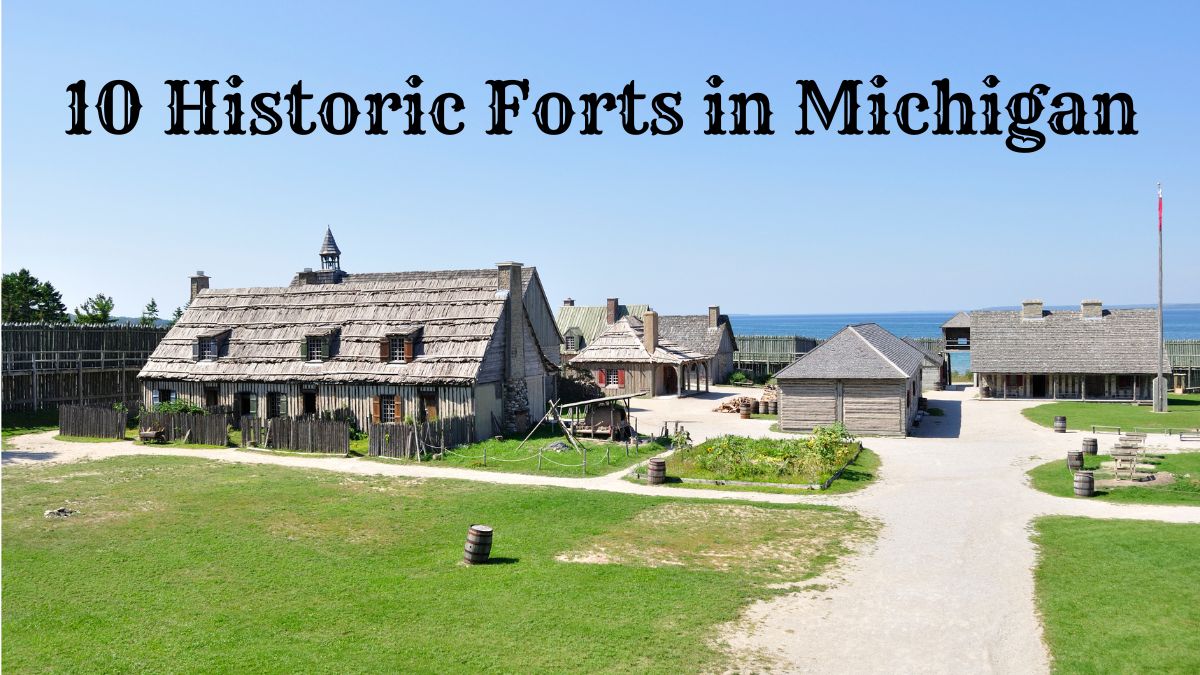
Thanks Cory, this was a very informative article.
Having lived in Michigan all my life I was not aware of all these forts. I was just up to Fort Mackinac on Mackinaw Island where I was amazed by it’s size and the historical significance it played! I enjoyed the re-enactments by Union soldiers depicting of the everyday lives of those times.
The only other fort I’ve been to was, Fort Wayne as a child. I have little memory of that other than getting a paper money of the period.
Thanks for sharing your experience Darryl!